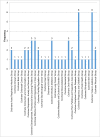Cluster Randomised Trials in Cochrane Reviews: Evaluation of Methodological and Reporting Practice
- PMID: 26982697
- PMCID: PMC4794236
- DOI: 10.1371/journal.pone.0151818
Cluster Randomised Trials in Cochrane Reviews: Evaluation of Methodological and Reporting Practice
Abstract
Objective: Systematic reviews can include cluster-randomised controlled trials (C-RCTs), which require different analysis compared with standard individual-randomised controlled trials. However, it is not known whether review authors follow the methodological and reporting guidance when including these trials. The aim of this study was to assess the methodological and reporting practice of Cochrane reviews that included C-RCTs against criteria developed from existing guidance.
Methods: Criteria were developed, based on methodological literature and personal experience supervising review production and quality. Criteria were grouped into four themes: identifying, reporting, assessing risk of bias, and analysing C-RCTs. The Cochrane Database of Systematic Reviews was searched (2nd December 2013), and the 50 most recent reviews that included C-RCTs were retrieved. Each review was then assessed using the criteria.
Results: The 50 reviews we identified were published by 26 Cochrane Review Groups between June 2013 and November 2013. For identifying C-RCTs, only 56% identified that C-RCTs were eligible for inclusion in the review in the eligibility criteria. For reporting C-RCTs, only eight (24%) of the 33 reviews reported the method of cluster adjustment for their included C-RCTs. For assessing risk of bias, only one review assessed all five C-RCT-specific risk-of-bias criteria. For analysing C-RCTs, of the 27 reviews that presented unadjusted data, only nine (33%) provided a warning that confidence intervals may be artificially narrow. Of the 34 reviews that reported data from unadjusted C-RCTs, only 13 (38%) excluded the unadjusted results from the meta-analyses.
Conclusions: The methodological and reporting practices in Cochrane reviews incorporating C-RCTs could be greatly improved, particularly with regard to analyses. Criteria developed as part of the current study could be used by review authors or editors to identify errors and improve the quality of published systematic reviews incorporating C-RCTs.
Conflict of interest statement
Figures
References
-
- The Cochrane Collaboration. Cochrane 2015. Available from: www.cochrane.org.
-
- Higgins J, Green S, (editors). Cochrane handbook for systematic reviews of interventions: Wiley Online Library; 2008.
-
- Donner A, Piaggio G, Villar J. Statistical methods for the meta-analysis of cluster randomization trials. Stat Methods Med Res. 2001;10(5):325–38. WOS:000171793800002. - PubMed
Publication types
MeSH terms
Grants and funding
LinkOut - more resources
Full Text Sources
Other Literature Sources


